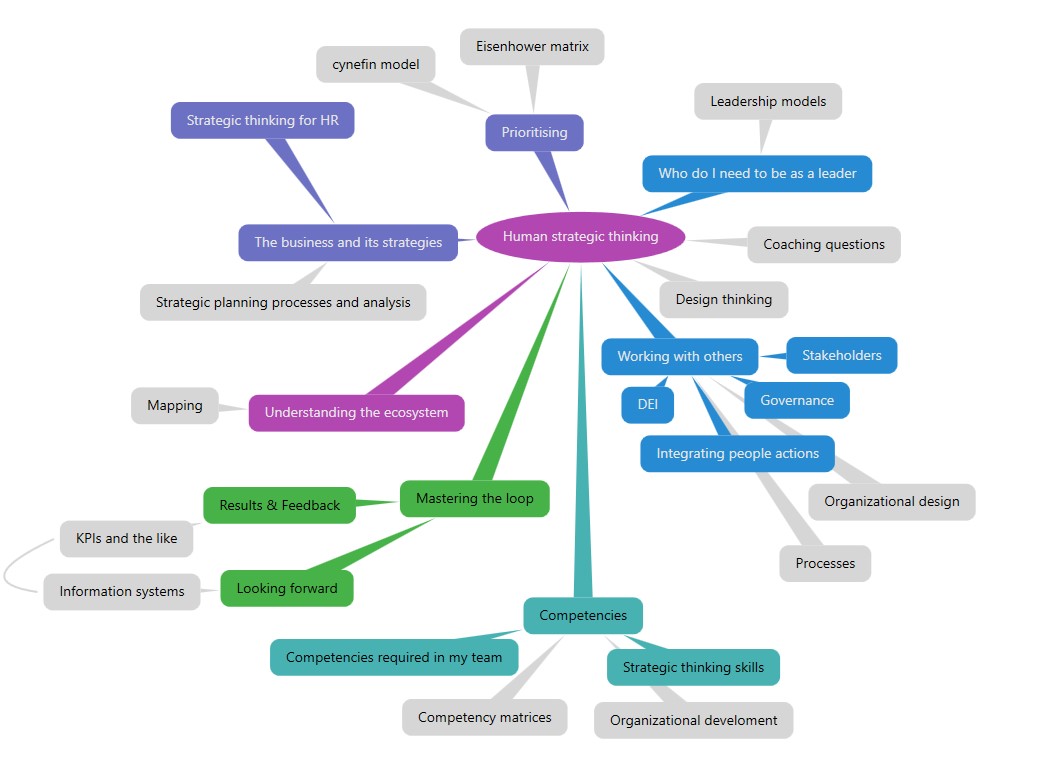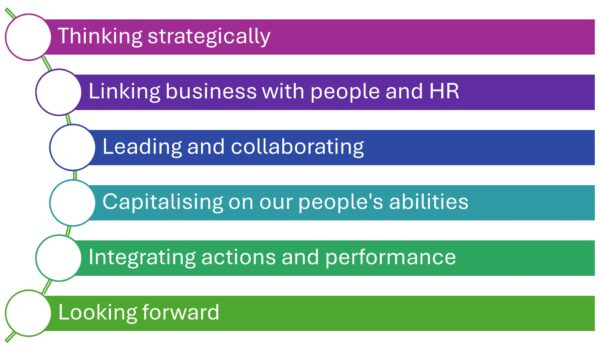Human Strategic Thinking

The Appleton Greene Corporate Training Program (CTP) for Human Strategic Thinking is provided by Ms. Petitpas Certified Learning Provider (CLP). Program Specifications: Monthly cost USD$2,500.00; Monthly Workshops 6 hours; Monthly Support 4 hours; Program Duration 12 months; Program orders subject to ongoing availability.
Personal Profile
Ms. Petitpas is a Certified Learning Provider (CLP) with Appleton Greene. She has over 30 years of experience in consulting, coaching, and training CEOs, executives, and management teams. She specializes in strategic thinking and planning, organizational development, human resources, and leadership. She is passionate about accompanying leaders in realizing and achieving their unique contributions, integrating the business and people aspects to create their desired impact on all stakeholders.
She has industry experience in the following sectors: Technology, Business Services, Biomedical, Consultancy, Manufacturing and Healthcare. She has worked with organizations with core activities in the following countries: Canada, United States, Mexico, and France, and more frequently within the following cities: Montreal, QC; Laval, QC; Québec, QC; Toronto, ON.
Her achievements include eight years as Founder of Polychrome, where she advises and coaches business owners and leaders to transform their organization and create value for all stakeholders based on their values and aspirations, capitalizing on the strengths of their teams; co-author of a book about strategic thinking, and is a regular contributor to LaReferenceRH.
Strategic thinking, management experience, and coaching have enabled her clients to reach significant insights and their organizations to evolve significantly and become more resilient, prosperous, and overall better as customer and employee experience providers.
To request further information about Ms. Petitpas through Appleton Greene, please Click Here.
(CLP) Programs
Appleton Greene corporate training programs are all process-driven. They are used as vehicles to implement tangible business processes within clients’ organizations, together with training, support and facilitation during the use of these processes. Corporate training programs are therefore implemented over a sustainable period of time, that is to say, between 1 year (incorporating 12 monthly workshops), and 4 years (incorporating 48 monthly workshops). Your program information guide will specify how long each program takes to complete. Each monthly workshop takes 6 hours to implement and can be undertaken either on the client’s premises, an Appleton Greene serviced office, or online via the internet. This enables clients to implement each part of their business process, before moving onto the next stage of the program and enables employees to plan their study time around their current work commitments. The result is far greater program benefit, over a more sustainable period of time and a significantly improved return on investment.
Appleton Greene uses standard and bespoke corporate training programs as vessels to transfer business process improvement knowledge into the heart of our clients’ organizations. Each individual program focuses upon the implementation of a specific business process, which enables clients to easily quantify their return on investment. There are hundreds of established Appleton Greene corporate training products now available to clients within customer services, e-business, finance, globalization, human resources, information technology, legal, management, marketing and production. It does not matter whether a client’s employees are located within one office, or an unlimited number of international offices, we can still bring them together to learn and implement specific business processes collectively. Our approach to global localization enables us to provide clients with a truly international service with that all important personal touch. Appleton Greene corporate training programs can be provided virtually or locally and they are all unique in that they individually focus upon a specific business function. All (CLP) programs are implemented over a sustainable period of time, usually between 1-4 years, incorporating 12-48 monthly workshops and professional support is consistently provided during this time by qualified learning providers and where appropriate, by Accredited Consultants.
Executive summary
Human Strategic Thinking
This program is both ambitious and down to earth. Ambitious in the sense that we will be aiming at increasing your strategic thinking skills so that you can apply them in the various types of decisions and actions that you are responsible and accountable for, and down to earth so that you may experience greater success, and create more value while implementing strategic or operational projects, both large and small. And though AI is at the top of the mind regarding business trends, we will focus on soft skills and human touch.
Why? The success track record of strategic and other change initiatives could be better.
Have you ever been in a situation where you know of a strategic plan within your organization, maybe even a plan that you have contributed to craft, but that somehow there is little that changes in daily operations? You are not alone. 90% of organizations fail to achieve their stated objectives when implementing their strategies. Yes, 90%. Even when strategies are well-formulated, 67% fail due to poor execution (HBR).
The pitfalls are numerous. There needs to be more time devoted to strategy implementation, with so many initiatives and changes to manage day-to-day and with all the volatility, uncertainty, and risks in the business ecosystems. According to a survey, 96% of leaders said they needed more time for strategic thinking. In comparison, 97% said this skill and the corresponding behaviors are critical to their organization’s success (HBR). Yet, we know the transformative power of implementing well-designed strategies as a source of meaning, alignment, and engagement.
According to Forbes, many critical obstacles to a successful strategy implementation are related to the people side of business. They include ineffective communication, alignment, change management, performance, and project management. And let us not forget the change fatigue experienced by employees. Indeed, A Gartner survey revealed that employees’ willingness to support enterprise change collapsed to just 43% in 2022, compared to 74% in 2016. This reflects that the number of change initiatives experienced by employees in 2022 was 10, as opposed to 2 in 2016. We have yet to fully understand and measure the impacts AI will have on all of us.
The HR function and people leaders’ roles are critical in resolving key issues
We discussed the business case above. Here we are focusing on the “human case”.
Among the 5 key HR priorities for 2024, according to Gartner, there are: leader and management effectiveness, organizational culture, and change management. They also shared that in 2023 research they conducted, that 83% of HR leaders are expected to do more, which includes a greater contribution to defining strategic priorities. Post-pandemic, we are observing that a significant importance is attached to how to best drive business results with and though their human capital, and this requires a close collaboration between leaders and the HR function.
As a leader, a manager, or an employee, you are tasked to contribute to achieving your organization’s annual and strategic objectives. Yet you do not always understand them, precisely what that means, or how your day-to-day is related to said goals. This is particularly true when so much is happening in your organization that it is difficult to know what is happening that could or will affect you. You may have been provided information, whether too little, enough or too much. But did it mean something to you, did it resonate, and thus, how much did you remember?
And, as someone once told me, sometimes life gets in the way… it may be life for your clients, colleagues, yourself, or someone dear to you. It may be the climate or any social or political event out of your control, yet that still has ramifications affecting you. Some of us seem to be better than others at dealing with changes, uncertainty, and stress, with how our bosses and colleagues react to it, with the power plays above your pay grade that cast yet another layer of fog or obstacles, with what that requires from you in terms of leadership and management and people skills.
What are the aims of this program? A focus on the people side to foster resilience and success
We will focus on strategic thinking and decision-making, weaving together the business and people strategies, priorities, and actions. There is no magic wand to create more time or to reduce the change fatigue experienced by many. There is, however, a different way of approaching decision-making, project, results, and people management, to increase clarity, a focus on the right priorities, collaboration, involving and supporting people to increase success and value creation for all stakeholders. According to Gartner, organizations promoting total experience are expected to outperform rivals in terms of CX and EX satisfaction indicators by as much as 25%.
Preparation is key. That starts with thinking strategically, understanding the objectives and why, the overall context, all that is happening in your organization, and the inevitable overlap and potentially conflicting priorities. Once the business side is clear and your priorities are well defined and understood, what does that mean for your team, as individuals and professionals, and for the required HR practices? The leadership and competencies required, the collaboration, and the appropriate success measures must all be integrated for more clarity and efficiency, of course, but also so the journey is more pleasant, and the value created encompasses all stakeholders.
And then? Well, things change, so the strategic competencies of anticipation and making sense of the data gathered are back at the forefront so we can readjust…and the loop goes on, one success and one learned element at a time.

McKinsey Case Study
In a 2023 article titled New leadership for a new era of thriving organizations, the authors, make the following observations:
• The new leadership requirements include the ability to create an engaging vision, a meaningful purpose, and be able to look forward.
• Leadership moves beyond an individual role, to one of collaboration as part of a network.
• The “human element’ is key, both for the leaders as individuals, and in creating favorable conditions for trust, and engagement, leading to successful transformation processes.
• This way of thinking and behaving is conducive to grater value creation.
They mention Aon and Intuit as organisation who have adopted such shifts in leadership thinking and practices and achieved better financial business outcomes, but also overall business and culture transformation.
Expressed in visual terms, here is the journey we invite you on.
We look forward to seeing you and to our discussions where all perceptions can respectfully and constructively be challenged and experiences shared so that after each session, there are some insights and ideas immediately applicable to your specific circumstances, helping the strategy and project implementation journey be smoother, and you and your team more resilient.
Curriculum
Human Strategic Thinking
- Month 1 Understanding the business: understanding the landscape
- Month 2 Strategic thinking at the organizational level
- Month 3 Linking the business with HR
- Month 4 Strategic thinking for HR
- Month 5 Prioritizing
- Month 6 Who do I need to be?
- Month 7 Working with others
- Month 8 Competencies
- Month 9 Talent
- Month 10 Integrating HR actions
- Month 11 Feedback loop
- Month 12 Looking forward
Program Objectives
The following list represents the Key Program Objectives (KPO) for the Appleton Greene Human Strategic Thinking corporate training program.
Human Strategic Thinking 
- Month 1 Understanding the business: understanding the landscape – HR and people management, in general, do not exist in a vacuum. They can both support the implementation of strategies defined by others and be an impetus for change and value creation. To do so, it is necessary to understand the organization’s business. This first step will allow participants to gain further clarity on their circumstances, the different types of strategies, and the value drivers of significant importance, beyond their understanding of their industry. They will consider the various ecosystems, both internal and external, that strategic plans and initiatives cater to and depend upon for successful implementation.
- Month 2 Strategic thinking at the organizational level – You know about strategies and strategic plans and how changing and volatile our environment is on many levels. On a day-to-day basis, operating while integrating strategic considerations is necessary. That is where strategic thinking comes into play. Learn how to think and act differently and ask different questions to ensure that your decisions and actions keep aligning with your organization’s strategies. We will also look at varying levels of strategic thinking and critical competencies to use in doing so.
- Month 3 Linking the business with HR – Now that you have taken the time to understand your organization’s business better and how to think strategically, what does that entail for you at the HR level? Or for you, as the leader of a team, large or small? You will be able to translate the answers into your HR/people plans and integrate operational and competency requirements. We will look at structure and governance aspects, the underlying messages, and some of the soft elements that can help or hinder understanding and engagement.
- Month 4 Strategic thinking for HR – We are now applying strategic thinking specifically to the HR function level to help you define the critical problem to solve and in crafting your vision. Determining with whom and how you/the function should collaborate will be crucial to your ability to create value, both with and for others within your ecosystem. There are many needs and stakeholders to satisfy and many definitions of success. Let us take an integrative look at these needs and how HR can contribute to achieving strategic, business, and people goals.
- Month 5 Prioritizing – We are all busy, so busy. It makes it difficult, at times, to assess whether the issues that require our time and energies the most are those that have the most significant impact. Our focus will be on how you can prioritize better and what processes you can put in place to ensure that you invest your time well. To prioritize means to choose what to focus on and what to set aside. The latter is typically more challenging. And your decisions affect how and to what your team devotes their time. Collaboration can be a significant help, and this requires taking a more global perspective on who are the “others” you would benefit from including in your expanded team.
- Month 6 Who do I need to be? – Thus far, we have taken a macro and team-level look at how to be more strategic in HR and people management. What about you as a person? We will explore who you need to be and some human aspects that can interfere with our ability to make good decisions. Cognitive biases affect how we perceive and how we decide. We all have some, so we will examine a few and how to circumvent them. Our exchanges will also address a few leadership traits that would benefit your organization to ensure success.
- Month 7 Working with others – Let us apply strategic thinking to delve deeper into the stakeholders you need to work with, their realities and constraints, and the structures and processes you can put in place to facilitate achieving results. How can you work more effectively (and pleasantly) with others, as a person, and as a representative of your function, team, or project? What ecosystems do you participate in, or do you need to interact with? What does the governance structure tell you, or what elements should you include in the one you put in place?
- Month 8 Competencies – Competencies are not simply words on a checklist. While some are easy to identify and describe, others not so much. How can you adopt a different perspective to identify those that are truly important, as opposed to nice to have, and to look at other ways to organize around competencies to drive results? And how do you integrate the long-term, strategic objectives into your mental model of what competencies are essential and for what purpose? The aim is to create more resilience and agility for the organization and its people as individuals.
- Month 9 Talent – Let us look at expanding the talent pool from a value creation perspective with a strategic thinking lens. And, of course, increase our awareness of some of the issues that prevent organizations from tapping into all the competencies in their labor pool and those preventing employees from contributing to the best of their abilities. The aim is to include a different perspective and to include diversity as an input and a contributor to results and impact. This is particularly important when there is a labor shortage or an imbalance between the needs and availability of specific skills and competencies.
- Month 10 Integrating HR actions – Many initiatives that focus on HR or affect people are often underway simultaneously. You have probably observed that different types of programs coexist that do not seem aligned or congruent, maybe even misaligned from stated corporate objectives. At the end of this section, you will know how to identify discrepancies and ascertain whether there is a need for a tweak or an overhaul to drive the desired impact.
- Month 11 Feedback loop – You have set a course and identified an action plan to achieve the objectives of a project or an initiative. How will you ascertain that you have reached both the “hard” results and the soft ones, relationship and people-oriented so your team remains aligned, engaged, and energized? Our aim here is to assist you in assessing what feedback is required and from whom to look at different processes that will allow you to gather data and ensure it can provide you with meaningful information facilitating strategic and operational decision-making. This feedback loop will include elements such as priorities and performance of both projects and individuals.
- Month 12 Looking forward – Things change fast, both within and outside your organization, affecting what and how you contribute. Let us take a deeper look at anticipation. What would be helpful if you could better anticipate? For your team? Your project? Your organization? What type of information and from what sources? Your answers will help you put in place a process (and refine it) to always keep an eye on the future and fuel your strategic thinking to help drive both results and impact.
Methodology
Human Strategic Thinking
The proven methodology behind Human Strategic Thinking is designed to help you as a leader reinforce your strategic thinking skills and weave in the people elements that are often at the root of projects or strategic plans not achieving their desired objectives, and that could become vectors of success, in terms of performance and of engagement. With a broadened view, and the ability to adopt a perspective encompassing the strategic, operational, and human elements, you will be better equipped to make the right decisions at the right time and positively.
We will use, among other things, stakeholder mapping, design thinking, an exploration of six critical strategic thinking competencies, coaching-type questions, principles of organizational design, the CYnefin model, the Contingency Theory of Leadership, Dilts’ neurological levels and Hudson’s wheel of change throughout our journey. At the end of this process, you will have had the opportunity to explore, ponder, apply, and see results.
Here is a visual representation of some of the topics and tools that will be used as part of this program.

Industries
This service is primarily available to the following industry sectors:

Technology
Digitization is everywhere, whether at the core of an organization’s purpose or as a means to an end. And the technology sector is a critical component of many countries’ and cities’ economies.
Both hardware and software aspects are associated with a need for or reliance on innovation and aim to enable organizations to achieve greater productivity and support growth. Intellectual property is significant and may be the impetus for mergers or acquisitions.
In a labor shortage context, AI-based tools can also alleviate the pressure from an insufficient talent pool and redirect human input to areas where its value is more significant. Chat boxes are increasingly common and sophisticated.
Technology is intimately tied to culture, organization, and workplace transformation, either as a cause, facilitator, project, or strategy. And if the potential for value creation is undeniable, all is not easy and well.
Issues and risks associated with technology include:
1. Data governance: what do we need, what for, and how is it managed?
2. Cybersecurity: accidental errors or deliberate attacks can create havoc for many organizations and their clients, large and small, including at the state level.
3. Fraud: Deep fakes are getting better, pun intended, at deceiving humans, and it is increasingly difficult to know what is “true” amidst the vast amount of “data” and “information” available.
4. Sustainability: clients are more and more focused on environmental costs and obsolescence when making choices regarding individual and corporate suppliers.
Also, technology companies frequently provide both products and services. These are articulated based on the targeted benefits for the client and can cater to all other industries. As is the case for different industries, there is a need for skilled resources and a disconnect between the existing talent pools and industry requirements.
The energy requirements of the technology sector and the sourcing of certain materials, such as rare earths, also pose unique challenges with respect to their direct and indirect environmental impact.
With all its promises and challenges, technology is here to stay, and its evolution is increasingly rapid. So, how do we, as an organization, implement the best framework to make the most of its strategic and operational potential?

Business and Professional Services
When talking about the business services industry, we refer to industries with a strong reliance on human contributions and little mechanical assets. Examples include field support and legal firms, advertising and translation, finance, accounting and engineering, facilities management, and staffing.
If, during economic expansions, they can provide much-needed additional resources, during more difficult times, they can assist their clients in optimizing internally or provide an easy avenue for cutting costs. They, too, must find ways to operate more efficiently and to embark on the technology and digital journey wisely.
Their success relies on the competencies and experiences put at their clients’ disposal, the trust that can be created, mainly when dealing with high-stakes decisions, and the profound understanding of their clients in all their complexity. And because each client is unique, while similar trends can be observed across an industry or location, they must be masters in adaptation and agility, with the right mix of thinking and doing, depending on their service offering and target markets.
The business services industry can be more at risk than others from the increasing development and use of artificial intelligence. Expressing opinions or cautionary tales concerning AI may not be so popular, though likely prudent.
In general, risks associated with the business services industry, other than the common cyber risks and eventual equipment problems, are related to their internal management, including employment practices, errors and omissions, talent availability, and engagement, as well as external aspects such as financial crises, third party issues or climate events.
Because of their “outside looking in” perspective, they are particularly well suited to assist their clients in making the most appropriate strategic decisions regarding their topic of expertise or making the right decisions at the right time to support the achievement of their strategic and operational objectives.
Manufacturing
Manufacturing is here to stay, for we, as individuals and organizations, will continue to need or desire an array of goods. The industry has made many changes in its quest for more efficiency and profitability. The off-shoring and just-in-time models have presented unique challenges to the supply chain during the pandemic and various geopolitical events since then.
Innovation, R&D, automation, and AI are both challenges and opportunities and part of what has been dubbed the fourth industrial revolution.
Manufacturers experience labor-related complexities that include highly skilled and non-skilled needs, local and immigrant employees, changing employee needs and aspirations, and changing client requirements that transpose into more and different skill requirements, including soft skills.
The manufacturing industry is also faced with difficult decisions, both strategic and operational, concerning the ESG components that are increasingly top of mind for both investors and clients, be they corporations or individuals. In some instances, this has led to decentralized manufacturing to reduce the physical distance between the plant and the user.
On the other hand, because it is an industry with, typically, pretty high salaries and high employment numbers, governmental entities are often inclined to invest significant amounts to attract new plants. There are also many opportunities for startups, including help from incubators and other organizations to accompany their journey to success.
Operational excellence, as is the ability to seize or create opportunities, is crucial. Strategic thinking will help ensure meaning and alignment on one or a few values or desired impacts and in integrating projects and initiatives as opposed to a siloed approach for greater efficacy and efficiency and, dare we say, shareholders’ satisfaction, whether internal or external.
Locations
This service is primarily available within the following locations:

Toronto
The greater Toronto area (GTA) is Canada’s most populous metropolitan area and economic capital, with the city contributing 20% of the nation’s GDP. It is also one of the most culturally diverse in the world, with over 140 languages and dialects spoken. Its workforce is highly educated.
Ontario’s capital boasts a median family median income above the Canadian median. It is the country’s leading financial hub, hosting the TMX stock exchange and all five largest Canadian banks’ headquarters.
The diversified economy benefits from hydroelectricity, access to raw materials, one of Canada’s largest major inland ports, and its busiest airport.
In terms of industries, in addition to the finance sector and manufacturing (mainly vehicle parts, food, and petroleum-related), are present:
• Media and entertainment, with Toronto being dubbed the “Hollywood of the north”.
• Life sciences, including biotech.
• Technology, of which it is a major center in Canada and North America.
• Tourism.
• Real Estate and Construction.
The GTA is also significant in that it can count on the majority of Canada-based large corporations and a large and active startup ecosystem.

Ottawa
Ottawa is Canada’s capital. Recognized as a bilingual city, immigrants comprise around 26% of the region’s population. The median household income ranks sixth in Canada.
The Canadian Federal Government is a key employer in the area. That being said, the region is host to a diversified economy, including one of the country’s busiest airports. Industries present include:
• Technology: this includes digital or media, software, communications, and clean technologies.
• Life sciences, also boasting two national life science Networks of Centres of Excellence (NCE).
• Aerospace, Defence, and Security, of which it is the national hub.
• Tourism.
There is a manufacturing presence comprised mainly of smaller organizations.

Montreal
The Montreal metropolitan area in the second most populous in Canada. It is the economic driver of Quebec, representing approximately 55% of the province’s GDP and 10% of Canada’s economy. Four universities are present, two of which are English-speaking.
It is the largest French-speaking community in Canada, with 60% of the city’s population speaking both English and French and 33% of the immigrant population, almost 24%, speaking three languages, making it a unique city in Canada.
The Greater Montreal Area economy is diversified and includes:
• Technology: information technology (of which it is a world hub), clean technologies, video games (one of the world’s top 5 locations), visual effects and animation, fintech, cybersecurity.
• Artificial intelligence, with the largest academic deep-learning community.
• Life sciences and biotech, as one of the main hubs on North America’s East Coast.
• Defense.
• Manufacturing, including food processing.
The startup and incubator ecosystems are thriving.
Program Benefits
Management
- Strategic Alignment
- Strategy Execution
- Value Creation
- Focus
- Coherence
- Opportunity Analysis
- Corporate Goals
- Foresight
- Governance
- Leadership Excellence
Operations
- Customer Experience
- Defined Responsibilities
- Process Improvement
- Collaboration
- Time Management
- Productivity
- Accountability
- Engaged Employees
- Resilience
- Competency Agility
Human Resources
- Business Alignment
- Clarity
- Shared Objectives
- Employee experience
- Embracing Change
- Engagement
- Retention
- Empowered Employees
- Defined Competency
- Increased Trust
Testimonials

Non-Profit Sector
From experience, not everyone in an organization is used to thinking strategically. Practicing this way of thinking together enables us to develop this type of thinking. How can we step outside our usual frameworks, experiment with our ideas, and learn, to inform the decisions that follow? How can we get to know the ecosystems to which we belong, and better evolve within them?
Strategic thinking enables us to discern the gaps between what’s happening on the ground and our objectives. An action plan becomes a living document when strategic thinking is employed. What is the meaning of an element, its purpose, its place in our overall actions? Does it bring us closer to our objectives and the expected longer-term impacts? What have we learned in the course of implementing the plan? And even: does the objective still make sense, in the light of our observations in the field?
Thank you for this pertinent contribution, which will nourish our individual and collective efforts to navigate complexity with clarity!

Financial Services Sector
Today more than ever, to combine operational performance with customer satisfaction, while taking into account cost efficiency and better risk management, organizations have no choice but to constantly project themselves into the future before making any decisions. Leaders need to adopt an innovative strategic posture, advocating flexible solutions that meet imminent needs, but are sufficiently proven to satisfy the vagaries of time.
Organizations will need to develop a vision of the future, based on a timetable of the areas to be worked on to achieve the desired results. The development of strategic thinking within an organization therefore proves to be the essential approach in the search for effective, sustainable solutions.

Technology Sector
What if business leaders asked themselves questions about the organizational issues facing their members? What if they adopted an agile and iterative approach, not only in project management, but also at the heart of their strategic decision-making processes? What if they offered stakeholders the agentivity they needed to make a real impact on their community and the organization’s social footprint?
This is the paradigm shift we’re talking about (…).

Retail Sector
We acknowledge the work carried out by Ms. Petitpas as part of a strategic human resources and organizational management mandate.
(…) She didn’t hesitate to make us a proposal, knowing full well that we’d be destabilized when we received it. Afterward, (…) she was able to put us at ease (…) and this led us to think about and see our organizational structure differently.

Logistics Sector
Ms Petitpas carried out an organizational strategy mandate.
The strategies targeted and introduced (following her intervention) have increased the profitability of our departments.
The efficiency gained (…) made us more effective and productive. What’s more, she was able to (help us) create an environment where employees feel privileged.
More detailed achievements, references and testimonials are confidentially available to clients upon request.
Client Telephone Conference (CTC)
If you have any questions or if you would like to arrange a Client Telephone Conference (CTC) to discuss this particular Unique Consulting Service Proposition (UCSP) in more detail, please CLICK HERE.















